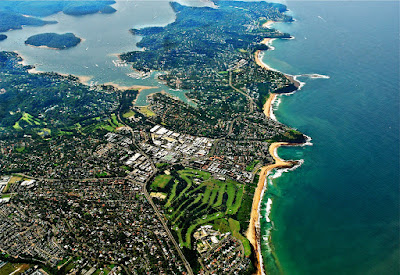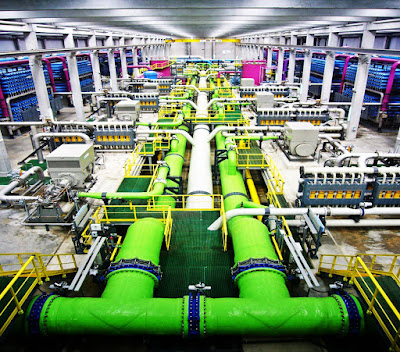Viability of Solar Energy can be a Game Changer
in Desalination of Water
Man has been exploiting nature in a way that has left several natural equilibriums in a state of distress. However, there are still two parts of our natural environment that are largely untapped, the deserts and the high seas. As a natural reservoir, they can absorb some of the externalities generated by human activities, and thereby relieve some of the environmental stress in other areas. One such area is need for greater vegetative mass for absorbing carbon, which can be served by afforestation of deserts.
Deserts are still an unutilized natural resource for mankind. Now, as existing natural resources face increasing pressure to cater to ever increasing human population on this planet, visionaries look at the deserts as a solution for last resort, but that needs water, which can come only by way of desalination of sea water. The seas can serve as the source of water for this purpose, provided we are able to tap it by processes of desalinization on a mass scale with the aid of renewable energy in the form of wind and solar. Effectively, it would amount to creating a new natural equilibrium with significant positive externalties.
 |
| Add caption |
On one hand, the humanity is faced with a severe impending crisis in the form of ever worsening global warming and climate change, and on the other hand, there is also a rising scarcity of both food and water. With an urgent need to expand agriculture to new arid zones while avoiding deforestation, the option of reclaiming and utilizing deserts is becoming more and more irresistible. The million dollar question, however, is whether it is a viable option? It is from this perspective that deserts and desalination of sea water can become one of our greatest hopes in the fight against climate change and global warming, with significant other positive externalities.
Deserts and Global Warming
The primary reason for global warming is the trapping of heat by green house gases, most of which are a result of carbon released from burning of fossil fuel. As the levels of green house gases rise, we need ways to not only reduce the release of green house gases, but also find ways and means to fix some of the carbon already released into the atmosphere. Till now, we are totally dependent upon our forests to fix carbon. The forest cover around the globe is under threat. There is very little scope of increasing the forest cover further, except of course, if we are able to somehow afforest the deserts and other semi arid territories.
In fact, rising global population and its rising needs for food continuously threaten further degradation of forests, particularly in lesser developed world. Simultaneously, it is giving rise to another great environmental challenge of providing adequate access to water. With only a very small fraction of our water being on the surface in rivers, lakes and ponds, these fresh water sources are already overexploited and cannot provide for great adventures like afforestation of deserts. If at all we wish to do add, we must be able to find a new ways. Technology holds the key, and innovation and entrepreneurship, along with support of global community and proactive States may hold the key in this life changing quest.
Afforestation of Deserts needs Water
Deserts hold the only hope for increasing forest cover today, which in turn remains our biggest hope for reversing climate change. Even if they are not afforested, the utilization of deserts for agriculture, which is far more feasible than their afforestation, can save precious land from deforestation. Either way, it can be that one large step in our fight with climate change, which we have been desperately waiting for. However, this requires enormous amounts of water, which does not exist in the deserts. With water from conventional sources becoming a scarce commodity that is already in short supply, all hopes of afforestation of deserts lie today with one source of water, the desalination of sea water.
What is Desalination and Where is it Practiced?
Desalinization or desalinization means removing salts from water so as to make it usable for purposes like drinking, cooking, irrigation and even certain industrial purposes.
Currently, it is a practice that is undertaken mostly for treatment of water, especially ground water with high levels of salinity, to make it usable. The very common Reverse Osmosis water equipment that are installed in millions of houses around the world are also examples of desalination equipment, even though they are installed primarily to make water safe from infectious agents such as bacteria and viruses. During the last two decades, cities in coastal areas facing water shortages have been increasingly looking at the option of desalination of water to solve their water shortage challenges.
What are the Common Desalination Processes?
There are two common technologies for desalination of water, the reverse osmosis process and the thermal evaporation methods, which are already in use for desalination processes. The reverse osmosis process is a more common process, particularly in smaller plants and is also utilized in household and industrial equipments, though not for desalination of sea water. The sea water desalination requires pushing water at very high pressures through a thin membrane which enables the passage of smaller water molecules while the larger salt molecules are retained. The thermal evaporation process, on the other hand involves heating of water, and its subsequent evaporation, which is then condensed to make soft and pure water.
Other processes for desalination which are not used commonly include distillation processes, freeze thaw, electrodialysis, nano tube technologies, electrothermal processes and electrokinetic processes. There are several other experimental processes, among which the adsoprtion processes that modify the vapor evaporation technology have evoked a lot of interest due to its potential practical feasibility in irrigation of deserts. The principle in this technology adsorption of water to an adsorbent, such as silica, which can adsorb water at lower temperatures and excrete it as temperature rises by a few degrees. Essentially, it is a thermal evaporation method, but one that can work in the normal temperature witnessed in a desert.
 |
| Reverse Osmosis Desalination Plant |
Is Desalination of Sea Water a Feasible Option?
Both desalination processes need significant energy inputs, in addition to initial investments in the equipment. The marginal costs of desalination, are largely dependent upon the energy required and its costs. In effect, if the marginal cost of energy can be brought down, the feasibility of desalination can also become feasible. Desalinization requires energy, and the best source of that energy would be the Sun. We need to find ways to make use of solar energy to desalinize and transport water from the nearby oceans to the deserts. One of the most important developments in recent years that has risen hopes about the possibility of desalination of sea water on a scale large enough to irrigate the desert lands is the improving technology and falling costs of solar energy.
As on date, desalinization is still considered a process that may be a little too costly for irrigation, particularly of the deserts. Fortunately, things are changing fast, and already there are some successful projects that have been able to tap sea water and desalinize it with the help of solar energy. The good news is that in 2017, the cost of solar energy has come down to a viable level. The vast deserts with little clouds generally provide a large catchment area for sunshine, providing enormous opportunity of harvesting solar energy in the deserts, which can then be utilized for desalination of sea water and its transport from the sea to the deserts. The opportunity of using this energy for industry also opens up the possibility of greater habitation of the deserts, which can itself be a strong stimulus for changing desert climate to a greener one.
As per reports of International Desalination Association, 18,426 desalination plants existed around the globe in June 2015, with a total output of 86.8 million cubic meters per day of desalinated water that served the needs of more than 300 million people. This number was an increase of over 10% increase from the figures of 2013. The largest desalination project at that points of time was Ras Al-Khair in Saudi Arabia, which produced more than one million cubic meters of desalinated water per day. Among countries of the world, Kuwait produces almost of all its water from desalination.
A number of projects are also under way in California. After a winter that was particularly scarce in terms of snowfall, which provides a valuable source of fresh water, Huntington Beach, a cast city in South California is in the process of taking measures aimed at providing a permanent end to its water problems by desalinization of water. There are several other projects also in the offing aimed at establishing and improving systems for mass scale desalinization of sea water with solar energy. These include projects run by commercial entities as well as by Academic Universities. Clearly, a lot of interest has been generated in the idea, not to mention about a lot more potential players, who are waiting for a certain level of progress to be made before they enter the ring!
Similar projects for desalination of deserts with sea water are also under way, or being considered in other places. In particular, countries like Israel, for whom overcoming the challenges of land, water and energy in a coordinated manner is a big priority, have already witnesses some success in such projects. The Sorek desalination plant, near Tel Aviv, was reported as the largest reverse-osmosis desalination facility in the world in 2015, and is helping Israel produce the fresh water than it badly needs. There are also reports that Israel is now considering building two more desalination plants. One emerging leader in Seawater desalination is China, which is reported to have more than 130 functioning desalination plants, with Tianjin Desalination Plant, which supplies water to Beijing Water Plant being the largest of them, with a capacity of 200,000 cubic metres of fresh water per day at a cost that is a little less than one dollar per cubic metre.
Even after this near impossible task is fulfilled, a lot more would need to be done. Only very selective plantations can survive in the deserts. Moreover, to create a layer of carbon and other nutrients requires enormous dumping of organic matter. Given the large scales of land that need to be targeted, a carefully strategy of selectively afforesting the deserts from the periphery will need to be followed. Begin with specialized arid plantation, use dripping methods, and gradually eat into the desert.
The challenges are enormous. The road is long and arduous. But where there is a will, there is a way. Maybe, the threat of global warming and climate change will become an opportunity for the afforestation of our deserts. In particular, new technologies like the adsorbent facilitated thermal evaporation hold significant potential in providing the breakthroughs that the world desperately needs to tap this so far unutilized tool in the fight against climate change.
References
- If we don’t want to run out of water, we shouldlook to the sun- Next generation solar technology could drive down thecost of scrubbing salt from seawater.
- Solar Desalination
- Israel Proves the Desalination Era Is Here
- Israel to Construct Two New Desalination Plantsin Fight Against Drought
- China’s desalination project tally tops 130
No comments:
Post a Comment